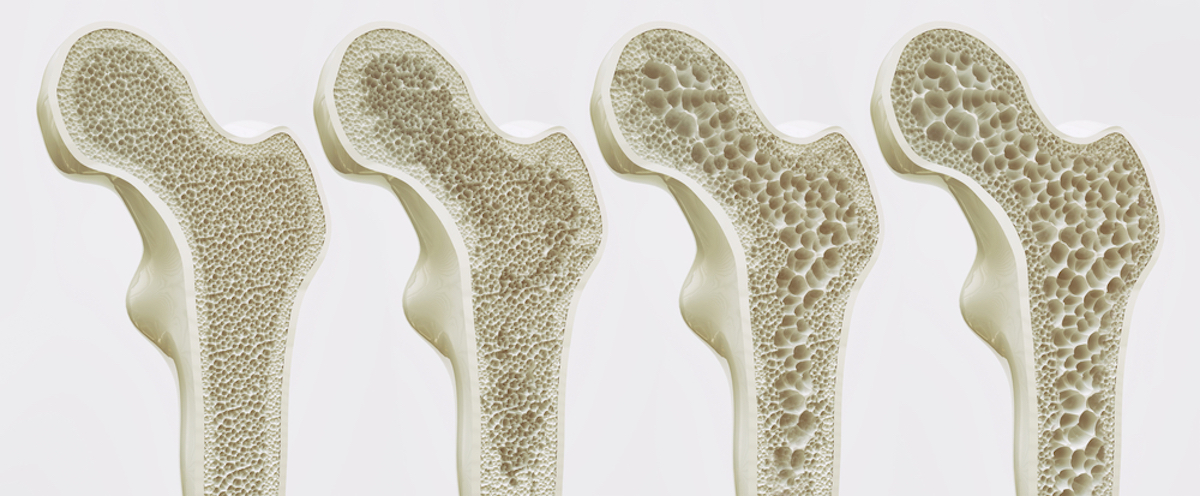As we age, not only does our age and appearance change, but the body also changes and experiences more difficulties. The likelihood of conditions such as fatigue, memory loss, high blood pressure, type 2 diabetes, and anemia increases. Also, the body itself can suffer from disorders, one of the most common disorders in our country is osteoporosis. Worldwide, the number of people who suffer from this condition is 200 million. In our country, the number is estimated at 54 million.

What Is Osteoporosis?
The translation of osteoporosis is literally “porous bone.” This immediately gives a clear picture of what the condition entails. When someone gets diagnosed with this condition, it means that this disease weakens the bones, by affecting the bone mass and bone strength. The inside of a bone looks like a sponge and when osteoporosis occurs the holes in the “sponge” are getting bigger and more numerous, which weakens the bone from the inside out. No worries, right? Well, you couldn’t be further from the truth, because this means you’re at risk for sudden and unexpected bone fractures.
Our bones are a vital part of our body, as this is our support system and protector of vital organs. In addition, it also stores important minerals such as calcium. This mineral is necessary for the process that keeps our bones healthy. After age 35, the bone breakdown happens faster than bone buildup, which causes loss of bone mass. When someone suffers from osteoporosis the loss of bone mass occurs even faster.
When Am I At Risk for Osteoporosis?
There isn’t a specific cause for why someone gets osteoporosis and why another doesn’t. Medical experts do know that a big part depends on how much bone mass someone attained in their younger years. The more you attained, the less likely it is for you to get osteoporosis. However, this varies per person as this is partly inherited and is influenced by several risk factors, like:
- Gender; women are 4x more likely to develop osteoporosis
- Age; the older you get, the greater the risk
- Ethnicity; Asian or Caucasian people are more likely to develop osteoporosis
- Body frame size; the smaller, the more likely to develop osteoporosis
- Lowered sex hormone levels
- Thyroid problems
- Overactive parathyroid and adrenal glands
- Diet, like low calcium intake and eating disorders
- Gastrointestinal surgery; it limits the amount of surface area available to absorb minerals
- Medication, like prednisone & cortisone
- Medical conditions, like cancer, rheumatoid arthritis, and inflammatory bowel disease
- Sedentary lifestyle
- Drinking alcohol
- Smoking
Osteoporosis happens in all bones, including in important bones such as the hip bone and vertebrae. The further the disease progressed, the faster the bones could break or be damaged. Think of falls, but bending over or coughing can also be a trigger. A hip fracture may look harmless, but besides the fact that it can lead to walking disabilities, there is also an increased risk of death in the 1st year after the bone is broken. Getting an early diagnosis can prevent a lot of damage, so make sure you know how to recognize the symptoms and what you should do next.

What Are the Signs of Osteoporosis?
Unfortunately, there are little to no symptoms in the early stages of bone loss. Once the bone mass gets affected by osteoporosis you can recognize the following symptoms:
- (Severe) back pain
- Loss of height (1 inch or more)
- Change in posture
- Bones that break too easily, sometimes even without falling (hard)
- Shortness of breath
Are There Any Treatment Options?
If you suspect you or a loved one is suffering from osteoporosis it’s important to talk with your professional healthcare provider about your suspicions. Your healthcare provider will examine you and if he/she deems it necessary do some tests. Think bone mineral density (BMD) tests & DEXA or DXA scans. Especially as you identify as a woman and are 65 years of age (or older) or fall into one of the previously mentioned risk groups make sure to ask about bone density. For men, if you are 70+ or fall into one of the previously mentioned risk groups: ask for a bone density test.
Once the correct diagnosis is made, a treatment plan can be set up. For osteoporosis this may include:
- Hormone and hormone-related therapy
- Bisphosphonate osteoporosis treatments
- Biologics
- Anabolic agents
- Vitamin & supplements
- Calcium-rich diet
The right treatment can really help you feel/get better. Remember: there is no best treatment, only the best treatment that suits you and your symptoms. For more information on osteoporosis and possible treatment options, continue your online search here:

